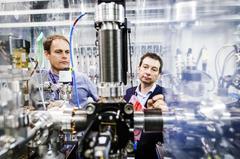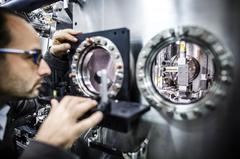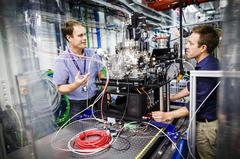URL: https://www.desy.de/news/news_search/index_eng.html
Breadcrumb Navigation
DESY News: First experiments at the European XFEL
News
News from the DESY research centre
First experiments at the European XFEL
A DESY-led team of researchers has successfully started the first scientific experiments at Europe's new X-ray laser European XFEL. The aim of the team led by Anton Barty and Henry Chapman from the Center for Free-Electron Laser Science (CFEL) at DESY is to decode the atomic structure of different biomolecules at the SPB/SFX experimental station of the European XFEL. “We are very happy that that the first users have now arrived at European XFEL so we can do a full scale test of the facility,” said European XFEL Managing Director Robert Feidenhans’l.

Anton Barty (left) and Henry Chapman (right) at European XFEL's experimental station SPB/SFX. Photo: DESY/Lars Berg
The tuning begins with the sample delivery to the X-ray beam. The X-ray flashes of the European XFEL follow one another at an incredibly fast pace of 220 nanoseconds – which means that in less than a millionth of a second four flashes arrive at the experimental station. The samples consist of tiny protein crystals that reveal information about their three-dimensional structure when X-rayed. However, for each crystal, this is a one shot only experiment, as the intense flashes vaporise the crystals almost immediately. So a new crystal has to be delivered into the X-ray beam every 220 nanoseconds.

SPB/SFX head Adrian Mancuso checking the sample chamber. Photo: DESY/Lars Berg
After calibration and tuning, the scientists plan to move on into uncharted territory, exposing proteins of unknown structure to the intense X-ray flashes. “Many, many people have worked long and hard to build this facility and this scientific instrument,” added Mancuso. “Now we see the first real data, working collaboratively together with our users, that marks the beginning of new experimental territory.”

Anton Barty (left) and European XFEL beamline scientist Richard Bean (right) discussing the experiment schedule at the SPB/SFX instrument. Photo: DESY/Lars Berg
”The instruments and the supporting teams have made great progress in the recent weeks and months,“ said Feidenhans’l. „Together with our first users, we will now do the first real commissioning experiments and collect valuable scientific data. At the same time, we will continue to further advance our facility and concentrate on further improving the integration and stability of the instrumentation.”
European XFEL is an international research facility with currently 11 shareholders from 11 countries. With a share of 58 per cent, DESY is the main shareholder. Leading an international consortium, DESY has developed and built the superconducting linear accelerator at the heart of the X-ray laser and is also operating it. The vision of an X-ray laser took off at DESY two decades ago. The initial plans for the European XFEL were developed at DESY, where the prototype of all X-ray free-electron lasers (XFEL) worldwide, FLASH, started scientific operation in 2005.



